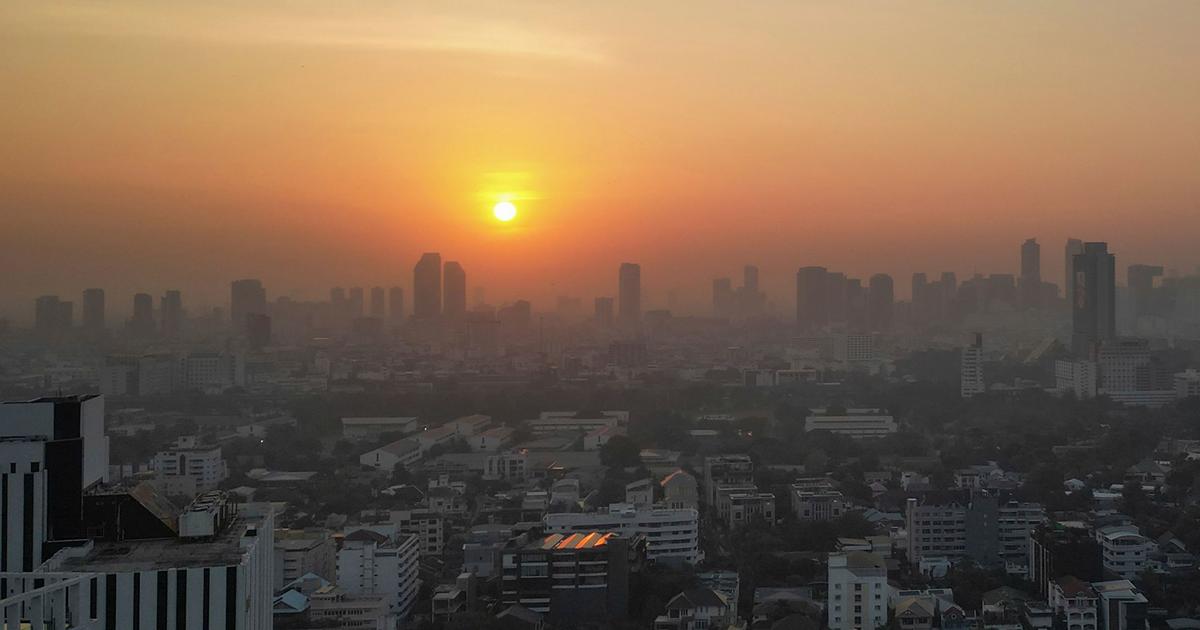health
news
In these cities in Israel, air pollution has caused more people to get sick in Corona
In a new study, Israeli researchers collected air pollution data and demographic and socio-economic data on 279 localities in Israel and examined how the morbidity of the corona in the previous waves of the epidemic was affected.
The results are worrying
Tags
Corona
covid-19
Air Pollution
Omar Yerushalmi, Angle
Wednesday, 11 August, 2021, 07:24 Updated: 08:42
Share on Facebook
Share on WhatsApp
Share on general
Share on general
Share on Twitter
Share on Email
0 comments
A method of dealing with insomnia
Who and what dietary fiber
Bennett: The future of the holidays depends on the number of vaccinators 5.8.21
Twins from different fathers
Facts about the mind
A mother was horrified by what she found behind her son's bed
Israel stores 60-plus-year-olds in third vaccine against ...
Five facts about tomatoes
Fire: Examining the possibility of tightening the green mark 2.8.21
Electric eel
coffee machine
The right amount of toothpaste to use
The alarming connection between air pollution in Israel and Corona (Zavit, Science and Environment News Agency)
We already thought the corona plague was behind us, and here it is again.
From the data accumulated in recent weeks that show a steep jump in the numbers of infected and critically ill, it seems that we are at the beginning of another wave of the disease - the fourth wave.
Unlike previous waves, today we are equipped with vaccines and a large knowledge base of studies on the coronavirus, the disease and its effects on humans.
Now, a new Israeli study sheds light on another angle concerning the three waves of morbidity in Corona in Israel (March 2020 - February 2021).
The bottom line is certainly worrying: in cities where there is chronically higher air pollution and in a population with a lower socioeconomic rating, higher morbidity has been observed.
More on Walla!
This is what exposure to air pollution in childhood causes in adulthood
To the full article
As of the end of July 2021 the corona had officially claimed the lives of more than 4.2 million people worldwide.
One can only speculate how much worse our situation would have been if, in most of the world, morbidity measures such as social isolation, isolation and closure had not been activated in time (when there was no other choice), and effective vaccines against the disease causing the disease would not have been developed in such a short time.
However, while the corona vaccine already exists, there is a silent killer around the world that causes premature death each year to the same extent as the official number of official corona victims so far - 4.2 million people - but does not receive the same public attention and unfortunately no vaccine - air pollution.
In which cities did the infection cause a higher morbidity?
People with masks in the Carmel market in Tel Aviv (Photo: Flash 90, Miriam Elster)
A disease that goes hand in hand with air pollution
It turns out that corona disease and air pollution go hand in hand. Already at the beginning of the epidemic, there were speculations in Israel and around the world that there was a link between chronic exposure to air pollutants, which has been known for many years to cause respiratory diseases, heart disease, stroke, lung cancer, type 2 diabetes, obesity, and even linked to negative births. Are also risk factors for more severe morbidity and mortality from corona), and morbidity and mortality from coronary heart disease that also affects the respiratory system. In a previous study published in the journal Environmental Research, Dr. Zohar Brent-Yitzhaki - a faculty member in the Faculty of Engineering and a researcher at the Dror (Emery) Aloni Center for Health Information Research at the Ruppin Academic Center and Dr. Adi Levy - Scientific Director of the Israel Ecological and Environmental Sciences Association And the head of the Department of Environment and Sustainability at Achva Academic College, tested these hypotheses at the global level.
In the study, the researchers analyzed the air pollution values of two common air pollutants: fine breathable particles (PM2.5) with a diameter smaller than 2.5 microns (thousandths of a millimeter) whose tiny size allows them to penetrate deep into the lungs and from there into bloodstream and nitrogen oxides. NOx) gases formed as a result of burning processes at high temperatures that stimulate the respiratory system and cause the development of bronchitis, asthma and impaired lung function. A study focusing on the 36 OECD countries found a link between the levels of air pollution that prevailed in these countries in previous years before the epidemic (chronic exposure) and the levels of morbidity and mortality from Corona in those countries.
In the new study, also recently published in the journal Environmental Research, the researchers sought to examine the effect of chronic exposure to five major air pollutants: breathable particles smaller than 10 and 2.5 microns in diameter (PM10 and PM2.5), nitrogen and sulfur oxides and carbon Monoxide (NOx, SO2 and CO) on coronary morbidity levels in cities and towns in Israel.
In addition, the researchers examined how demographic and socioeconomic parameters affected morbidity levels.
Already at the beginning of the epidemic, a connection between infection and disease was suspected.
Air pollution in Gush Dan (Photo: Walla! NEWS system, Reuven Castro)
"In the present study we examined the morbidity peaks in the three waves of morbidity that occurred in March and September 2020 and January 2021, as well as the morbidity peak in July 2020 that preceded the second wave," explains Dr. Burnett-Yitzhaki. In the 36 OECD countries, this time we wanted to examine the issue at a higher resolution and examine whether there is a relationship at the locality / city level in Israel between the level of chronic exposure to air pollutants between 2016-19 and the incidence of corona in those localities. This is a resolution of 279 localities and cities in Israel on which we collected data. In addition, we examined the connection between the morbidity in Corona and the demographic and socio-economic factors that characterize those localities. "
Levy and Brent-Yitzhaki tested the levels of pollution in five different air pollutants: nitrogen oxides (NOx) that irritate the airways, create an inflammatory response and impair lung function; Carbon monoxide (CO) which reduces the oxygen carrying capacity of red blood cells; Sulfur oxides (SO2) that irritate the airways and create an inflammatory response and hypersensitivity to infections; As well as respirable particles smaller than 10 and 2.5 microns (PM2.5 and PM10), these penetrate the upper airways to the depths of the lungs, and the smallest of them are able to reach the bloodstream as well. These contaminants (PM) have in the past been linked to a very wide range of cardiovascular and respiratory diseases and have even been recognized by the International Agency for Research on Cancer (IARC) as a definite carcinogen in humans. All five of these pollutants reach the air we breathe daily mainly as a result of burning fossil fuels in vehicles, power plants and industry, but also naturally as a result of dust storms (particles) and forest fires (particles and oxides).
The researchers examined the relationship between the levels of chronic exposure to these pollutants in the various localities in Israel and the level of morbidity from corona disease during the first three waves of morbidity.
Lower percentages of morbidity.
The beach in Rishon Lezion, January 2021 (Photo: Reuven Castro)
"We have seen that in the first two waves there is a clear link between chronic exposure to air pollutants and morbidity in the corona," says Brent-Yitzhaki.
According to the study, in cities with high air pollution, such as Tel Aviv, Rishon Lezion and Jerusalem, there was more morbidity during the first two waves than in cities where air pollution was lower, such as the city of Nahariya.
More on Walla!
The World Health Organization is coming out against a third vaccine for corona
What are the chances that your children will suffer from Post Corona Syndrome?
Tired of an unbearable diet?
There is an effective, natural and healthy solution
Prioritizing underprivileged populations
However, in the third wave, which was characterized by the highest morbidity to date and was widespread in all parts of the country, no link was found between air pollution levels and morbidity levels. "In the third wave, we found a clear connection between socio-economic factors and the level of morbidity from Corona," says Brent-Yitzhaki. "In this wave, Jerusalem and Be'er Sheva had a higher percentage of morbidity than in Tel Aviv or Rishon Lezion."
The researchers examined several demographic and socio-economic indices among them: density, infant mortality rate, matriculation eligibility percentages, the socio-economic cluster to which each locality is associated and the natural growth rate of the various localities. The corona virus - which is supposed to be “blind” to the socioeconomic status of those it infects - has led to wider morbidity in localities from lower socio-economic backgrounds. "In all the waves, we found a certain connection between the socio-economic and demographic situation and the level of morbidity," says Brent-Yitzhaki. "For example, in the first and second waves, the higher the density of cities, the higher the morbidity levels. But while in the first two waves we also saw an association with air pollution, in the third wave, which peaked in mid-January this year, only socioeconomic cluster and growth "The natural population in the locality was found to be in significant association with the differences in morbidity."
Respiratory particles increase susceptibility to disease and you may also carry the virus directly into the lungs.
Fire in the Jerusalem area (Photo: Niv Aharonson)
Similar trends have also been observed in other studies around the world for example in the US and UK, where populations from low socioeconomic backgrounds (especially African-Americans, Hispanics and immigrant populations) were more vulnerable to Corona morbidity, partly due to relatively large households living in small apartments and cohabitation of young people. Adults and the elderly in the same apartments Similar household characteristics exist in Israel in the ultra-Orthodox, Arab and Bedouin sectors, many of whose localities belong to socio-economic clusters 1-3 (1 low, 10 high).
What happened in the third wave?
According to the researchers, there are several possible reasons for the loss of the link between chronic exposure to air pollution and morbidity levels in the third wave. The hypotheses include the widespread contagion effect that occurred in the third wave across the country and the emphasis on large and intergenerational households in sectors living in low-socioeconomic communities, as well as the vaccination campaign that began in the last third of December 2020 and provided some protection for the elderly The air - against the disease of corona disease.
However, due to the primacy of the information and its complexity, it is not possible at this stage to give an unequivocal answer.
In any case, in anticipation of the next waves of the disease, Levy and Brent-Yitzhaki recommend that the authorities prepare better by emphasizing the treatment of underprivileged populations and low-socioeconomic communities with large or multi-generational households living in small residential units, with home isolation of patients. Is not a possible option.
Giving priority to those populations to the possibility of evacuation for isolation in a motel or other orderly treatment complex, could reduce the spread of the virus within homes and reduce harm to these populations.
Air pollution increases the body's sensitivity to viruses and bacteria
However, beyond the link found in the study (in correlations and models of multivariate linear regression) that is not yet causal, how exactly can exposure to air pollution affect coronary heart disease? "So far no definite mechanism has been found, but science now knows of at least three mechanisms by which air pollution harms the body and can increase the risk of coronary heart disease: Air pollution impairs the function of respiratory epithelial cells, these cells secrete mucus and by means Viruses and bacteria outside our respiratory system. A decrease in the number or function of those lashes makes it easier for disease agents to enter the body. Recently offers the possibility that the virus takes a "ride" on air pollutants - respirable particles (PM) to the depths of the lungs,"That may make it easier for him to attack the body," Levy explains.
Researchers have recommendations for better preparedness for the next wave of morbidity.
Vaccinated in line for a third vaccine in Petah Tikva (Photo: Reuven Castro)
Even before the corona broke into our lives, air pollution took its toll on Israel and caused the untimely deaths of more than 2,000 people each year.
It was also found that the entire population in Israel is exposed to concentrations of PM2.5 and PM10 that exceed the target values of the Clean Air Law.
"We now have a golden opportunity to take steps that will ensure a triple and even square profit for the Israeli public: a dramatic reduction in fossil fuel burning (oil, coal and natural gas) and a rapid transition to renewable energies and electric transportation will reduce air pollution to Israel." The current significant investment in underprivileged populations in Israel has the potential to significantly improve their health and well-being while saving future medical care costs for the country. Now that following the results of many recent studies in the world and our studies, it seems that reducing air pollution has the potential to reduce the incidence of respiratory viruses such as the corona virus,Due to the possibility of reducing the extent of morbidity in some of the "background diseases" and the sensitivity of our respiratory system to pathogens, "Levy concludes.
The article was prepared by Zavit - the news agency of the Israeli Association of Ecology and Environmental Sciences
Share on Facebook
Share on WhatsApp
Share on general
Share on general
Share on Twitter
Share on Email
0 comments








/cloudfront-eu-central-1.images.arcpublishing.com/prisa/VPFDJ6LOFBD4DJB77PGQNQCUCE.jpg)
